On and from 1 January 1948 the railways of Cambridge came under the Eastern Region and London Midland Region of British Railways. For a while, little changed and even pre-nationalisation ticket stocks continued to be used; some still being issued into the 1960s from a number of lesser used stations. The most immediate visible changes were minor ones, such as headings on paperwork, posters, timetables and so on. As far as trains were concerned, many locomotives and carriages continued to carry their pre-nationalisation identities until c1951 but some subtle changes did begin to creep in almost immediately; locomotives bore a regional prefix to their numbers and the legend British Railways began to appear on tenders and side tanks while coaching stock numbers began to receive prefix and suffix letters to indicate the region they operated on (prefix) and the regions of their original owning companies (suffix). But changes to coaching stock were slow.
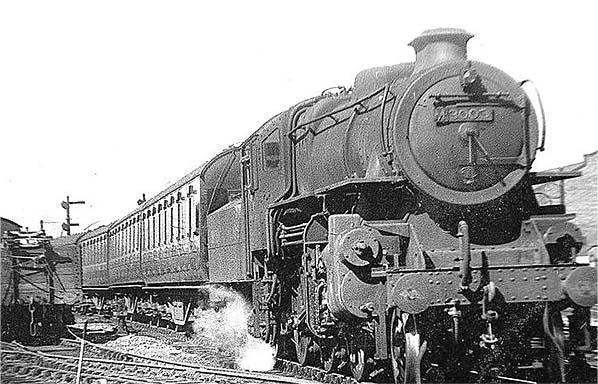
Photo by John Ford from David Ford's Flickr photostream
Above Ivatt 4MT M3003 is seen departing platform 3 with a train for the Bedford line. The tender carries British Railways in full and an M has been added to the number on the smokebox. These little plates were of cast iron and applied simply by using the existing bolt at the lead end of the existing numberplate and the system was peculiar to the London Midland Region. Further Ms were applied to the cabsides, usually just above the number. This was an interim measure and M3003 would later become 43003. The train is formed of ex-LMS suburban stock, this being quite common on this route. The Ivatt 4MTs were built from 1947 and the class totaled 162. The type was common at Cambridge and some were allocated to 31A, as Cambridge shed became under BR.
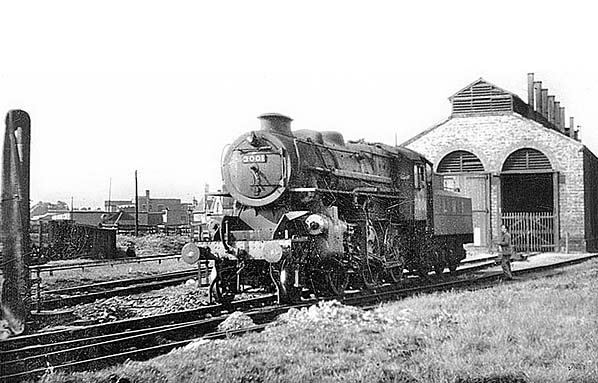
Photo by John Ford from David Ford's Flickr photostream
Above the second-built 4MT can be seen outside the closed ex-LNWR shed. Both the above photographs were taken in 1948, just after nationalisation. 3001 was still in LMS livery when photographed and had yet to receive the M prefix. The locomotive is on stand-by duty and will be in light steam. After the LNWR shed closed, this became an LNER duty, despite an LMS locomotive being used, and following nationalisation it was a BR Eastern Region duty. The use of crews from one region working on locomotives from another was common practice in steam days. Another example, relevant to Cambridge, was a Cambridge crew working a duty booked for an 8F on the Bedford line.
To the left of 3001's smokebox part of the building which very nearly became the Bedford & Cambridge/LNWR passenger terminus can be seen although it is not entirely clear how much work had been done when it was decided to allow LNWR trains into the GER station. The building was much altered over the years, especially the street frontage as seen in Part 2.
 The Ivatt 4MTs were odd looking machines with their high running plates and double chimneys. The first fifty were built with double chimneys but were soon converted to single chimney due to the poor performance the original design gave. The class was given a variety of derogatory nicknames, the best known being 'Flying Pigs' but nonetheless there was something about them which made them rather fascinating to see in action. The BR Standard 4 2-6-0 was a tidied up version of the class. The Ivatts survived until 1968 and one, 43106, has been preserved.
The Ivatt 4MTs were odd looking machines with their high running plates and double chimneys. The first fifty were built with double chimneys but were soon converted to single chimney due to the poor performance the original design gave. The class was given a variety of derogatory nicknames, the best known being 'Flying Pigs' but nonetheless there was something about them which made them rather fascinating to see in action. The BR Standard 4 2-6-0 was a tidied up version of the class. The Ivatts survived until 1968 and one, 43106, has been preserved.
Some rather patchy LMS records survive concerning the former LNWR engine shed. At some point after the war Messrs Meredith & Drew were interested in leasing the shed but for what purpose is not known. At around the same time, however, the LMS proposed to demolish it. Dates leasing the shed are not recorded but on 28 March 1947 the LMS proposed a 'roadway to disused shed' and this is thought to have been in connection with Meredith & Drew's proposal. As events were to prove, nothing came of the scheme and it was left to British Railways to eventually deal with the disused shed.
Meredith & Drew were once well known cake and biscuit manufacturers based in Shadwell. They held a Royal Warrant and after 137 years of existence were digested by United Biscuits in 1967. Today United Biscuits owns many famous names such as Jacob's and McVitie's but of Meredith & Drew not a crumb remains.
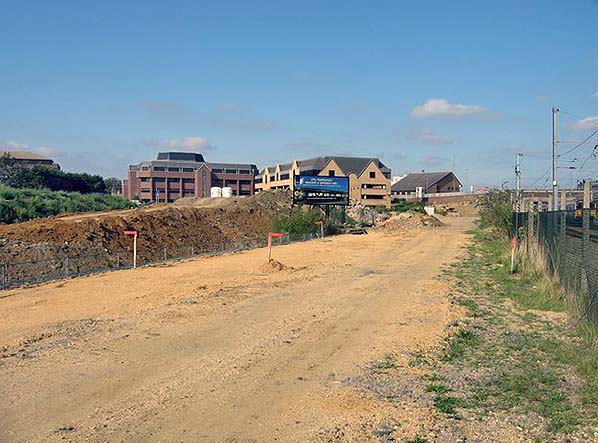
Photo by Sebastian Ballard reproduced from Geograph under creative commons licence
Above, for comparison with the view of 3001, is the same location in August 2008 albeit taken from a little further back. Where funny rubber tyred railcars, Black 5s, 8Fs, 4MTs and so on once ran, the ground is now being prepared for the guided busway. The building the other side of Hills Road is Cambridge power signal box.
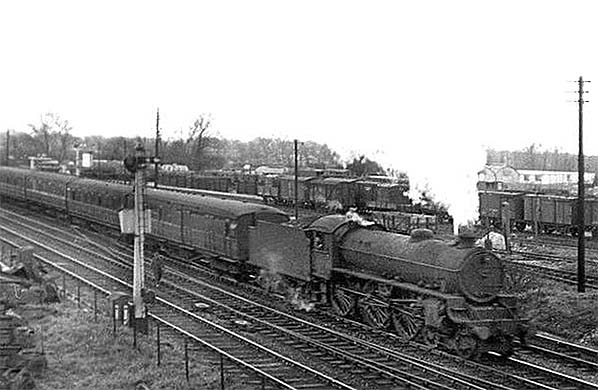
Photo by John Ford from David Ford's Flickr photostream
Above, an unidentified B1 approaches Hills Road bridge with a local service from one of the London lines, probably King's Cross, in early BR days. On the left the shunt signal with theatre indicator can be seen; the specific purpose of which is unclear. To the right of the B1 the LNWR water crane with a pile of ash beside it. The water crane stood roughly where the photographer was positioned in the previous, modern, image.
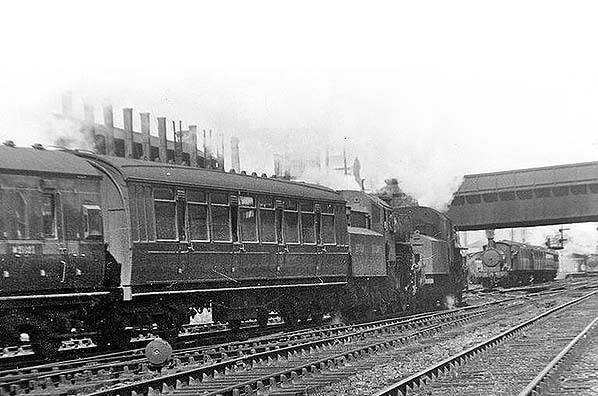
Photo by John Ford from David Ford's Flickr photostream
Well we did say the Ivatt 4Ms were common at Cambridge! Above is an unidentified pair coming off the Bedford line and about to pass beneath Hills Road bridge, again in 1948. When double heading occurred, the leading locomotive was the pilot engine and the second the train engine. Double heading was not exactly rare on the ex-LMS line to Cambridge and, unless it was to rescue a failed locomotive, it was often done to save a light engine path. Of the pair seen above, one would return to Bletchley on a passenger service while the other may return with a goods train or relieve another locomotive on the stand-by duty. On the left the distinctive roof of the LNWR shed is seen while beyond the bridge an ex-GER E4 is on station pilot duty; it has drawn out of the platform so will be running under the control of shunt signals. A crew member is leaning out of the cab. The carriage is of interest; it has a look of LNWR about it and may be an LMS Period 1 vehicle. Perhaps somebody with knowledge of LMS coaching stock will let us know.
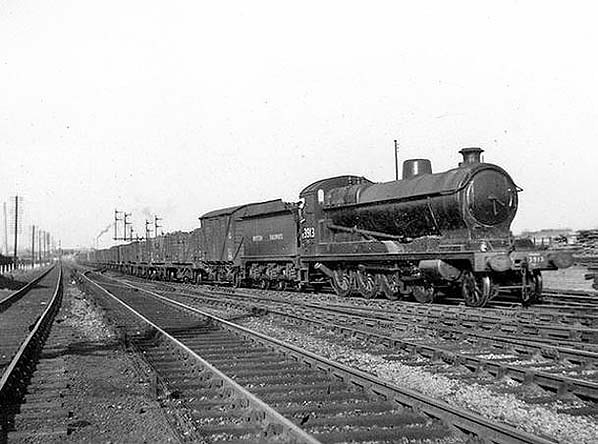
Photo by John Ford from David Ford's Flickr photostream
Above is class 04/6 2-8-0 E3913, again in 1948. The locomotive appears to be quite smart in its interim BR livery. It would later become 63913 and at the time of the photograph was Cambridge based. The train has operated via the St Ives loop and is at Coldham Lane sidings, just north of Mill Road bridge, crossing over to enter Cambridge up goods yard. 63913 was later transferred to Yorkshire.
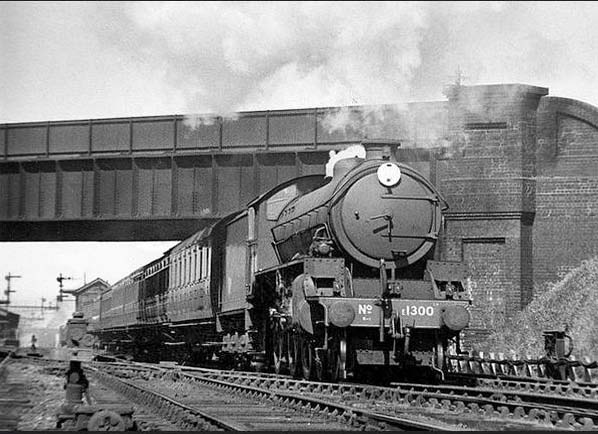
Photo by John Ford from David Ford's Flickr photostream
Above is Thompson B1 E1300 leaving Cambridge with a Liverpool Street stopper. This locomotive was actually built by BR and was new in March 1948, the photograph being taken soon afterwards. There is no obvious sign of any lettering or logo on the tender. A Cambridge engine when new, she was withdrawn from March in November 1963 but was to go on to become one of the last steam locos in the region as Departmental 23 until finally withdrawn sometime towards the end of 1965. Seventeen B1s were converted into carriage preheating units although one of these was a replacement for another. The conversions could - and did - still move under their own power but officially had their drawgear removed to prevent use as motive power; in practice the couplings were removed but drawhooks retained. Presumably this was to allow shunting when not in steam.
Several of these conversions were used at Cambridge. Dept. 24 (ex-61323) was sent to Cambridge in October 1963 but apparently was not used. Dept. 21 [not to be confused with the Y3 which bore that number] (ex-61233) heated carriages at Cambridge until April 1966. Dept. 23 (ex-61300, the loco pictured above) did the same job until November 1965. Carriage preheating at Cambridge had, during the 1950s and prior to the departmental B1s, been carried out by J67 and J69 tank locos. In the diesel era the job was done by converted BR horseboxes fitted with steam generators or by purpose built heating vans. With the advent of electrically heated coaching stock, preheating was achieved via a shore supply and Cambridge was so equipped.
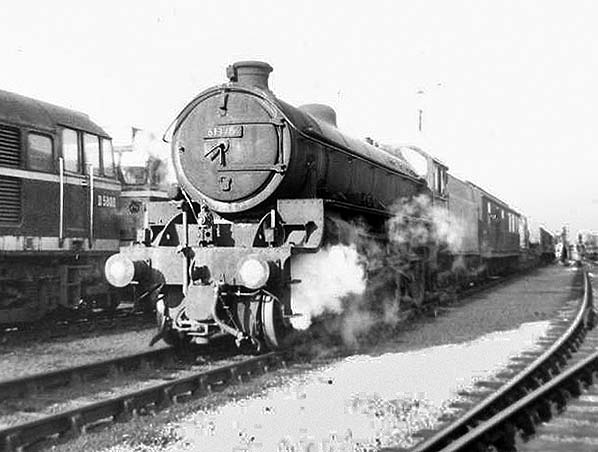
Photo by Stewart Ingram
Above, B1 61326 is carriage heating in March 1965. Information with the image states the locomotive was by this time Dept. 24 so bearing in mind comments above, the departmental number must have been reused and this was indeed known to have happened in a few instances. Photographic evidence of these carriage heaters suggests it was usual to leave the smokebox numberplate in situ even though it was redundant. As we have seen, these locomotives could still move under their own power and needed to for positioning purposes but they were not permitted to haul trains. There was, however, exceptions and one was pressed into use at Ipswich to rescue a class 15 diesel which had run through a buffer stop and ended up partially in a residential street.
Dept. 24 and probably others had been fitted with a device on the front of the right running plate. It can just be seen to the left of the smokebox, as we view the locomotive, above. The device appears to have been some sort of blower as there was a pipe, not visible above, leading from it into the smokebox but precisely what this device was is not known at the time of writing. It is also not known why 24 is apparently linked-up with the breakdown train. Perhaps the mess and tool van, the old clerestory carriage, needed warming up.
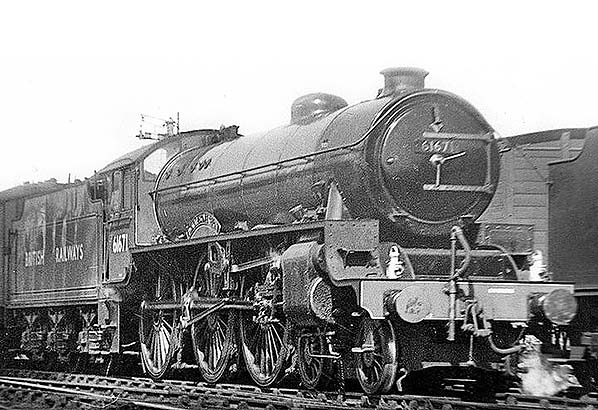
Photo by John Ford from David Ford's Flickr photostream
Again in 1948 we see, above, class B2 61671 'Royal Sovereign'. The location appears to be the south end carriage sidings, opposite platform 1. 'Royal Sovereign' was one of a pair of the class kept spruced up by Cambridge shed for Royal Train duties and is seen here in all her lined green glory. She has a proper six-figure numbers but retains the full lettering on the tender. The other Royal B2 was 61617 'Ford Castle', held in reserve for 'Royal Sovereign'. As explained in Part 4, there was much name juggling among the B2s and B17s and the 'Royal Sovereign' name was later transferred to 61632 which then became of official Royal engine.
 On 11 February 1952 'Ford Castle' hauled the funeral train of King George VI from Wolferton to King's Lynn where 70000 'Britannia took over to take the train south to King's Cross. After lying in state at Westminster Hall, the coffin was taken to Paddington and onward to Windsor where the late King was buried in St George's Chapel. Cambridge was not unfamiliar with such scenes at King Edward VII and King George V had also died at Sandringham and the same procedure had been followed.
On 11 February 1952 'Ford Castle' hauled the funeral train of King George VI from Wolferton to King's Lynn where 70000 'Britannia took over to take the train south to King's Cross. After lying in state at Westminster Hall, the coffin was taken to Paddington and onward to Windsor where the late King was buried in St George's Chapel. Cambridge was not unfamiliar with such scenes at King Edward VII and King George V had also died at Sandringham and the same procedure had been followed.
Royalty to or through Cambridge by train was, and still is, a not infrequent occurrence, either in connection with events at Cambridge University or to/from Sandringham. Today Her Majesty The Queen and other members of The Royal Family are more likely to travel by ordinary service train to avoid the expense of using the Royal Train which is said to currently cost over £50,000 each time it is used. Her Majesty is quite familiar with the class 317 and 365 electric multiple units, incredulous as that may seem.
The B2 class consisted of just ten locomotives. They were Thompson 2-cylinder rebuilds of 3-cylinder Gresley B17s but the programme was halted as the success of the Thompson B1 class rendered the scheme pointless. By the mid 1950s the entire B2 class was allocated to Cambridge and the last was withdrawn in 1959.
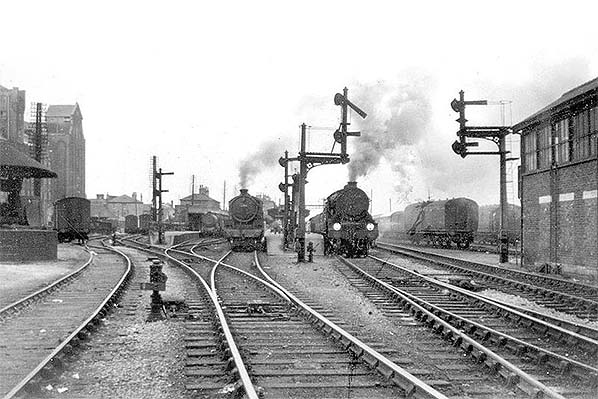
Photo by John Ford from David Ford's Flickr photostream
Again in 1948, above we have an unusual view of Cambridge South. A B1 stands at platform 2 and a B17 at platform 1. The B1 has received a smokebox numberplate but the B17 apparently has not. An unidentified locomotive stands in platform 3 and above it can be seen the former GNR station building. All signals seen in this view were installed as part of the 1926 resignalling. To the immediate right of where the photographer is standing once stood the pre-1936 South signal box. The bandstand-like structure on the far left was a crane and photographic evidence suggests it had gone by the early 1950s. The B1 at platform 2 does not appear to have a train behind it, suggesting it has been released from an incoming train but this theory is thrown into doubt by the locomotive facing south. It is probably simply waiting in the bay to take over another southbound train or to collect stock from the carriage sidings. The use of the Cambridge bay platforms in this manner was not uncommon. Just to the right of the B17 what appears to be an ex-LNER varnished teak carriage with white roof can be seen.
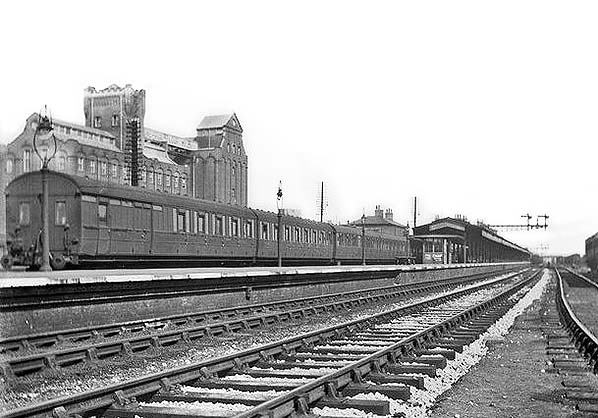
Photo from Duncan Chandler's GER Album
The above image was thought to have been taken by the late Frederick Russell but it is believed to date from around the time of nationalisation. As F.V.Russell died in 1942 the source of the image is in doubt and thus credited as Unknown. Russell was once the very capable assistant to the GER's James Holden.
While most rail enthusiasts were in absolute awe of the 'Cambridge Buffet Express' (CBE) to the almost total exclusion of anything else, the above scene shows the more workaday side of Cambridge station. The train is a King's Cross outer suburban set composed of articulated stock. On the end of the brake vehicle King's Cross Outer Suburban lettering can be made out and King's Cross appears to be written in full (see image of 61619 below). In the distance, another train waits at platform 4 and the shadow from the carriages on the extreme right suggests the photograph was taken during a summer evening. The wartime platform edge markings are still clearly visible although becoming quite worn by this time. Old North Road station, on the Bedford line, retained this type of platform edge marking up until it closed on 1 January 1968. The change in the platform face brickwork was probably the result of one of the several platform extensions. The attractive gas lamps replaced earlier casement lamps c1938 and, as we will see later, became the subject of a very peculiar method of mounting BR station totems.
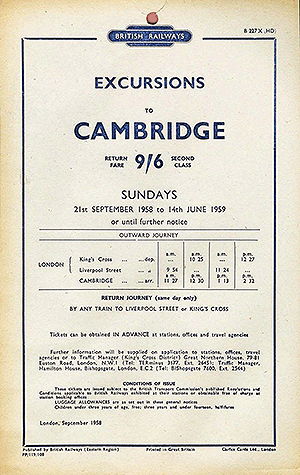 The 'Cambridge Buffet Express' and 'The Fenman' were a couple of named trains which once served Cambridge. The CBE was introduced in 1934, suspended during the war, reinstated and latterly ran every two hours during weekday daytimes, plus a mid-evening journey following a lengthy gap due to the number of peak time stopping services occupying the line. Its proper title was 'Cambridge and Garden Cities Buffet Car Express' and it survived until the King's Cross outer suburban services were electrified in 1978. It was nothing more than a semi-fast outer suburban train which included a buffet car. For such a short journey, one might think a buffet car would not be worthwhile but it proved to be very popular. The CBE once carried carriage roof boards but latterly it carried no identification. 'The Fenman', once carried a headboard but its use was discontinued sometime after diesels took over.
The 'Cambridge Buffet Express' and 'The Fenman' were a couple of named trains which once served Cambridge. The CBE was introduced in 1934, suspended during the war, reinstated and latterly ran every two hours during weekday daytimes, plus a mid-evening journey following a lengthy gap due to the number of peak time stopping services occupying the line. Its proper title was 'Cambridge and Garden Cities Buffet Car Express' and it survived until the King's Cross outer suburban services were electrified in 1978. It was nothing more than a semi-fast outer suburban train which included a buffet car. For such a short journey, one might think a buffet car would not be worthwhile but it proved to be very popular. The CBE once carried carriage roof boards but latterly it carried no identification. 'The Fenman', once carried a headboard but its use was discontinued sometime after diesels took over.
It ran once per weekday to Liverpool Street from King's Lynn, departing the latter at 07:30, but at one time had a portion attached from Hunstanton, departing from there at 06:45. It departed Cambridge at 08:48 and ran non stop to Liverpool Street. There was also the later unofficially named 'Bury Fenman'; this departed Ipswich at 07:12 and called at all stations to Cambridge before departing there, following a lengthy dwell, at 08:58. Previously it originated as a portion from Bury St Edmunds, departing 07:47, which joined the main train at Cambridge. It then called at Audley End and Bishop's Stortford on its way to Liverpool Street. This train was popular with Cambridge passengers as it was the first train on a weekday on which cheap day returns to London were valid. It was also the last regular locomotive hauled passenger train on the Ipswich - Cambridge line. These trains disappeared with electrification north of Cambridge. 'The Fenman' name was to make one more brief appearance; when the line north of Cambridge was electrified (electrification originally ended at Cambridge), there was a rather awful publicity stunt made by placing a makeshift 'Fenman' headboard on the front of of, of all things, a class 317 EMU working the inaugural up service from King's Lynn. Thankfully, this idea was to remain a one-off.
There was a corresponding down 'Fenman'; 16:30 from Liverpool Street, arriving Cambridge after a leisurely run at 17:50. The Bury portion, which also called at Newmarket, departed Cambridge at 17:58 while the King's Lynn / Hunstanton portion departed at 18:04. Arrival at King's Lynn was 19:14 and Hunstanton 19:55. One curiosity was the down service; on Fridays-only it called additionally at Magdalen Road, if required, to set down passengers who had boarded at Liverpool Street or Cambridge but only at those two stations. Magdalen Road station, once closed, is today Watlington. Presumably the Magdalen Road request stop was for the benefit of any passengers travelling to Wisbech, for which Magdalen Road was the junction station. The Magdalen Road - Wisbech line closed in 1968 and the Hunstanton line in 1969, but by that time the Hunstanton branch had been reduced to a DMU shuttle from King's Lynn with, as happened at many other locations, just a single track remaining at the terminus.
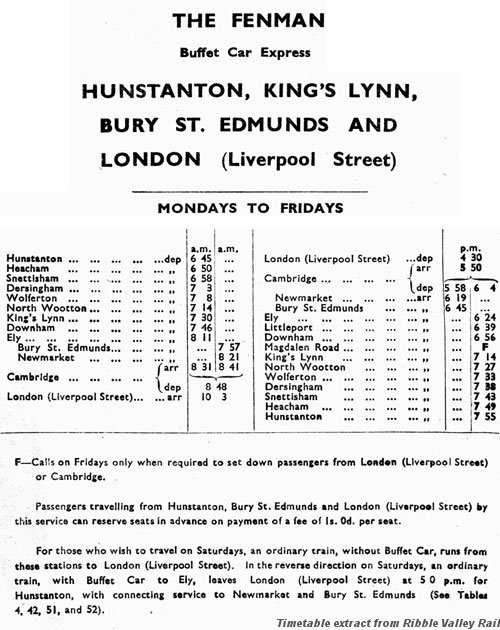
The times given above are representative; both the CBE and 'The Fenman' ran at roughly the same times throughout their lives but precise times varied by a few minutes over the years. The down 'Fenman', for example, departed Liverpool Street at 16:36 by the late 1960s. As explained, in later years the Bury portion of up 'Fenman' was altered to start from Ipswich and ran through to Liverpool Street but lost the title and thus ran as an ordinary service. It departed Cambridge ten minutes behind the real 'Fenman'. There was by this time no corresponding down service; passengers for Newmarket (etc) having to change at Cambridge onto a DMU.
Ribble Valley Rail is the user group for the Blackburn - Clitheroe line and their website has a collection of details of named trains, including others which once served East Anglia, as well as timetables dating back over a century and other interesting information covering not just Britain but other parts of the world.
Click here to continue Part 5:
British Railways - The steam era



 The Ivatt 4MTs were odd looking machines with their high running plates and double chimneys. The first fifty were built with double chimneys but were soon converted to single chimney due to the poor performance the original design gave. The class was given a variety of derogatory nicknames, the best known being 'Flying Pigs' but nonetheless there was something about them which made them rather fascinating to see in action. The BR Standard 4 2-6-0 was a tidied up version of the class. The Ivatts survived until 1968 and one, 43106, has been preserved.
The Ivatt 4MTs were odd looking machines with their high running plates and double chimneys. The first fifty were built with double chimneys but were soon converted to single chimney due to the poor performance the original design gave. The class was given a variety of derogatory nicknames, the best known being 'Flying Pigs' but nonetheless there was something about them which made them rather fascinating to see in action. The BR Standard 4 2-6-0 was a tidied up version of the class. The Ivatts survived until 1968 and one, 43106, has been preserved.






 On 11 February 1952 'Ford Castle' hauled the funeral train of King George VI from Wolferton to King's Lynn where 70000 'Britannia took over to take the train south to King's Cross. After lying in state at Westminster Hall, the coffin was taken to Paddington and onward to Windsor where the late King was buried in St George's Chapel. Cambridge was not unfamiliar with such scenes at King Edward VII and King George V had also died at Sandringham and the same procedure had been followed.
On 11 February 1952 'Ford Castle' hauled the funeral train of King George VI from Wolferton to King's Lynn where 70000 'Britannia took over to take the train south to King's Cross. After lying in state at Westminster Hall, the coffin was taken to Paddington and onward to Windsor where the late King was buried in St George's Chapel. Cambridge was not unfamiliar with such scenes at King Edward VII and King George V had also died at Sandringham and the same procedure had been followed.

 The 'Cambridge Buffet Express' and 'The Fenman' were a couple of named trains which once served Cambridge. The CBE was introduced in 1934, suspended during the war, reinstated and latterly ran every two hours during weekday daytimes, plus a mid-evening journey following a lengthy gap due to the number of peak time stopping services occupying the line. Its proper title was 'Cambridge and Garden Cities Buffet Car Express' and it survived until the King's Cross outer suburban services were electrified in 1978. It was nothing more than a semi-fast outer suburban train which included a buffet car. For such a short journey, one might think a buffet car would not be worthwhile but it proved to be very popular. The CBE once carried carriage roof boards but latterly it carried no identification. 'The Fenman', once carried a headboard but its use was discontinued sometime after diesels took over.
The 'Cambridge Buffet Express' and 'The Fenman' were a couple of named trains which once served Cambridge. The CBE was introduced in 1934, suspended during the war, reinstated and latterly ran every two hours during weekday daytimes, plus a mid-evening journey following a lengthy gap due to the number of peak time stopping services occupying the line. Its proper title was 'Cambridge and Garden Cities Buffet Car Express' and it survived until the King's Cross outer suburban services were electrified in 1978. It was nothing more than a semi-fast outer suburban train which included a buffet car. For such a short journey, one might think a buffet car would not be worthwhile but it proved to be very popular. The CBE once carried carriage roof boards but latterly it carried no identification. 'The Fenman', once carried a headboard but its use was discontinued sometime after diesels took over.

 Home Page
Home Page